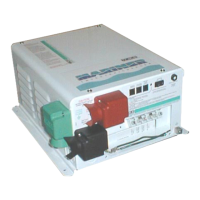,167$//$7,21
&RS\ULJKW7UDFH(QJLQHHULQJ&R,QF 7HOHSKRQH 3DUW1XPEHU
WK
6WUHHW1( )D[ 2FWREHU
$UOLQJWRQ:$86$ ZZZWUDFHHQJLQHHULQJFRP 3DJH
a given ambient temperature. Testing has shown that the volume of the enclosure is not as
important as the overall ventilation. As long as a minimum airspace of 1 ò - inches is maintained
around the sides of the inverter, and three inches at the back of the inverter with the cooling fan,
adequate ventilation should be maintained. Because the top of a Mariner chassis is not vented,
clearance between the enclosure and the top of the inverter is not relevant. A fresh air intake
opening should be provided directly to the fan if possible, and an exhaust port directly opposite that
will allow cool outside air to flow through the inverter and back out of the enclosure.
0RXQWLQJ
The inverter must be mounted on a horizontal surface. The purpose of this requirement is to orient
the inverter so that its has no openings that will allow sparks or ignition sources to be ejected in the
event of an internal fire. Secure the inverter to a shelf or deck to prevent movement during rough
seas. Place flexible washers on the mounting screws or bolts between the shelf or deck and the
inverter chassis to reduce vibration from the propulsion system while underway.
2Y HUYLHZRI0DULQH$& DQG'&6\VWHPV
This section defines terms commonly used in marine electrical systems, and describes typical AC
and DC marine systems. This is a brief overview. For more information regarding marine electrical
systems, refer to the following publications:
Boat Owner’s Electrical Manual,
2
nd
Ed. 1995 by Nigel
Calder and
12-volt Bible for Boats
by Miner Brotherton, or
Boat Owner’s Illustrated Handbook of
Wiring
by Charlie Wing.
Terminology
The following terms are derived from ABYC Standard E-9:
AC Grounding Conductor: A conductor, not normally carrying current, used to connect the metallic
non-current-carrying parts of electrical equipment to the AC system and Engine Negative Terminal or
its bus and to the shore AC grounding conductor through the shore power cable.
DC Grounded Conductor: A current-carrying conductor connected to the side of the source which
is intentionally maintained at boat ground potential (DC negative ground bus).
DC Grounding (Bonding) Conductor: A normally non current-carrying conductor used to connect
metallic non current-carrying parts of DC devices to the Engine Negative Terminal or its bus for the
purpose of minimizing stray current corrosion.
Engine Negative Terminal: The point on the engine at which the negative battery terminal is
connected (with the Mariner inverter, this connection is made to the DC Ground bus).
Ground: Refers to the potential of the earth’s surface. The boat’s ground is established by a
conductive connection (intentional or accidental) with the earth, including any conductive part of the
wetted surface of the hull.

